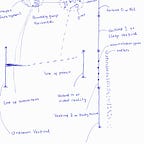Mental Health Awareness Includes How it Converges at Thought
If someone got a message that led to sadness, hurt, anger or happiness, that message became a thought that went to the memory — to be known — then advanced elsewhere in the brain. If someone sees or smells something to result in a similar effect, it did so, by that transport.
Thought can also emerge internally {the memory} to lead to similar effect, but to do so, they have to go to a similar spot.
Things are often sensed but effects are not the same — showing that seeing or knowing what is seen, is exceeded by a corresponding feeling effect.
Whatever is called mental health is a lot about thought, emerging, getting known — accurately or inaccurately, then going somewhere in the brain.
It is agreed that mental disorders are poorly understood, but across what intricacies?
Depression, anxiety, affective disorder, PTSD and more vary in their quandary on people, but there is no mental condition without thought. Thought may seem too active, too static, too repetitive or too dominant, but thoughts are there.
So instead of mental health questionnaire, hasty prescriptions, substance abuse or general therapies, a more direct find across conditions is how did thoughts emerge and travel in this situation?
Patients would be shown scenarios of thoughts and their pathways in cases, then told to choose the closest to what it is for them to determine the direction of intervention.
The Brain and Mental Health
Most senses are integrated in the thalamus, then relayed to the cerebral cortex. Smell is integrated at the olfactory bulb and relayed to areas including the orbitofrontal cortex.
It is proposed that senses are integrated into thought or a form of thought: it is in this form that the memory stores information. There is a thought version of anything external: car, house, plate, it is the thought version the memory knows, gives and uses to relate with the world.
There are base feeling and feeling effect. Hunger, heat, thirst, pain, and so on are base feelings, as they are by hormones, receptors. Happiness, sadness, anger, irritation are effects that may follow base feelings.
It is proposed that the thought version of hunger, heat or pain, went to the memory to be known — that something isn’t right, and journeyed to the destination for effect: sadness, anger, irritation and so on. With food, hunger goes, then thought leaves the effect destination.
Opioids can also be explained with this, as taking thought away from that destination, not necessarily that the base feeling of pain totally vanishes. This also explains many psychoactive substances as well as the hold of substance abuse. The memory has preference for lightness, so addiction may ensue.
In mental health, words, losses, disappointment, hurt and so on become thought, get to the memory and head directly for feeling effect, without any base feeling. This makes it difficult to fix, since it is not like irascibility — from hot weather — that would go away by ventilation.
When thoughts are down at feeling effects, for long, it gets more attention and draws power from the memory, depriving checks of normality from other functions, and may either result in lethargy, fast heart rate or breathing and so on.
Conclusion
The world inside the human brain is the world every human knows. Resemblances are copious, but differences overrule perception and response. It is not often about what should be obvious or easy, but what the brain says to do according to how the brain unit {or thought} of that individual navigates within.
In seeking to know the brain, an important question is how it sets up a world, without exposure to the world? Senses are collected, integrated, relayed, known, felt and responded to.
Across locations in the brain, there is a uniform unit that travels, bending, shaping and adjusting towards output specified for the individual — according to nature or change.
There are many centers in the brain, but it is when thought or its form gets there that they get activated. Thought transport and emergence holds the key to progress in mental care.
